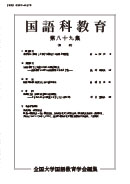Volume 89
Displaying 1-8 of 8 articles from this issue
- |<
- <
- 1
- >
- >|
-
2021 Volume 89 Pages 1
Published: March 30, 2021
Released on J-STAGE: May 26, 2023
Download PDF (20K)
-
2021 Volume 89 Pages 3-11
Published: March 30, 2021
Released on J-STAGE: April 01, 2021
Download PDF (701K)
-
2021 Volume 89 Pages 12-20
Published: March 30, 2021
Released on J-STAGE: April 01, 2021
Download PDF (697K)
-
2021 Volume 89 Pages 21-29
Published: March 30, 2021
Released on J-STAGE: April 01, 2021
Download PDF (821K)
-
2021 Volume 89 Pages 30-32
Published: March 30, 2021
Released on J-STAGE: April 01, 2021
Download PDF (354K)
-
2021 Volume 89 Pages 33-36
Published: March 30, 2021
Released on J-STAGE: May 26, 2023
Download PDF (404K) -
2021 Volume 89 Pages 37
Published: March 30, 2021
Released on J-STAGE: May 26, 2023
Download PDF (180K) -
2021 Volume 89 Pages 38-47
Published: March 30, 2021
Released on J-STAGE: May 26, 2023
Download PDF (608K)
- |<
- <
- 1
- >
- >|
